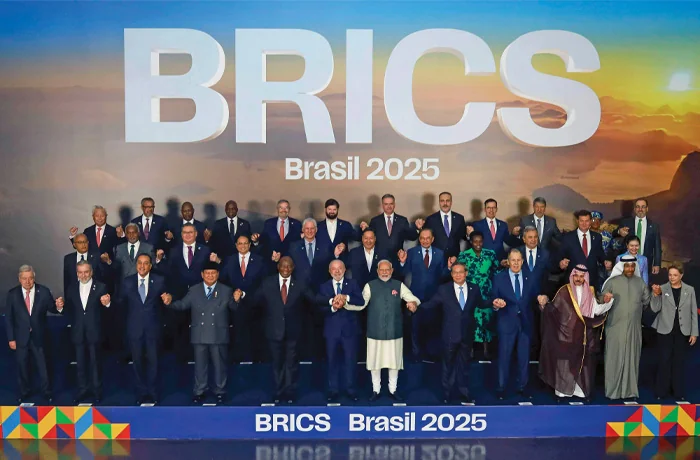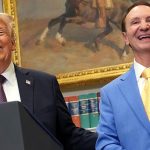As the threat and reality of U.S.-imposed tariffs around the world continue, the increasingly influential group of countries known as the BRICS bloc is also flexing its muscle.
What started as the emerging economies of Brazil, Russia, India, China, and South Africa has now become an 11-nation trading and political bloc, with Indonesia becoming the latest member state to join in January 2025.
Several other countries, including Saudi Arabia and Nigeria, are partner countries of the bloc. Currently, the member countries account for approximately 45% of the world’s GDP and more than half of its population.
And, as the world focuses on what the United States under President Donald Trump may eventually land on with all the threats of global tariffs, the BRICS nations have made their own statement.
At the 17th BRICS summit in Rio de Janeiro in July, the group announced that, among many other commitments, “We are now extending our commitment to strengthening cooperation within the expanded BRICS, based on three pillars of cooperation: politics and security, economy and finance, and cultural and people-to-people cooperation.”
Trump responded to the BRICS summit on July 7 via Truth Social by threatening an additional 10% tariffs on “any country aligning themselves with the Anti-American policies of BRICS.” Since then, he has also further threatened Brazil with more tariffs conditional upon greater freedom for convicted former President Jair Bolsonaro, his close ally.
Crucial juncture?
Some now see the world potentially being at a “critical juncture in history” as a result of such geopolitical and economic shifts. Others are urging more caution, remaining confident in the power of the U.S. economy to hold sway.
While the U.S. retains considerable institutional power through its leadership of global financial bodies such as the International Monetary Fund, the World Bank, and the World Trade Organization, the legitimacy and authority of such institutions face increasing challenges from groups such as BRICS, said Irina Tsukerman, president of Scarab Rising, a geopolitical risk consultancy.

“Many states have grown skeptical of the impartiality of these organizations, viewing them as mechanisms for advancing Western economic and geopolitical interests,” Tsukerman said. “As a result, alternative institutions are being created or expanded to dilute U.S. dominance.”
George Oikonomou, a Greece-based economics consultant, said threats to emerging economies such as those in the BRICS bloc will only strengthen cooperation between such countries against the U.S.’s influence.
He noted that the dollar’s hegemony is already declining, given a significant decline in dollar global foreign reserves since the turn of the century. Meanwhile, intra-BRICS trade is growing faster than BRICS-G7 trade, with projections showing intra-BRICS trade exceeding $500 billion by 2026.
“At this point, someone should really ring the danger bell in the White House,” Oikonomou said. “Multiple indicators suggest the U.S. is losing its grip on global economic leadership. Overall, the intersection of BRICS expansion and Trump’s tariff threats represents a critical juncture in global economic history.”
Others are perhaps more sanguine. For example, the latest BRICS summit failed to make significant progress on a BRICS currency or credible financial alternatives, according to Saurav Sen, a senior analyst of emerging markets at New York-based Gimme Credit.
“The July 2025 BRICS summit in Rio confirmed what’s been clear for a while,” Sen said. “The dream of a new financial order is running out of steam.”
Indeed, the bloc’s expansion may well result in ever-increasing divergence. Its best hope may be nudging the United Nations to a less Western tilt.
“For now, BRICS is more posturing than policy,” Sen said.
Any perception that the U.S. is a fading power should be tempered by the reality that it is still the world’s largest consumer market. Tariffs may be disruptive in the short term, but they can help address debt problems and lead to global manufacturers relocating production to the U.S.
“While global geopolitical shifts naturally raise concerns, the U.S. has a long track record of resilience and the ability to adapt when needed,” said Philip Battin, president and founder of Ambassador Wealth Management. “It’s important to keep a balanced perspective and not let fear take hold. The challenges are real, but so are the opportunities for strategic renewal and leadership.”
The times they are a-changing
Whether we are at such a critical juncture or not, most everyone agrees on the global cultural, economic, and political shifts that are happening irrespective of the continued power of the U.S.
One way to temper U.S. dominance is through dedollarization, a move away from the dollar as the dominant trading currency.
“If the de-dollarization of international transactions took place, it would have significant implications, such as U.S. Dollar depreciation, higher U.S. borrowing costs, and loss of U.S. geopolitical leverage,” said Brandon Parsons, an economist at Pepperdine Graziadio Business School.
Nevertheless, Parsons added, the reality is that around 90% of international transactions are conducted with the U.S. dollar, and that will not change overnight.
“The US economy is still the largest, and no country wants to lose access to the U.S. marketplace,” he said. “However, there is potential that high tariffs on exports into the U.S. marketplace could lead to continued efforts toward de-dollarization of international transactions, as well as new trade coalitions that could alter geopolitical influence in regions around the world.”
Logistically, trade lanes are shifting, with BRICS nations investing heavily in alternative corridors. China’s Belt and Road Initiative has funneled over a trillion dollars into infrastructure across Asia, Africa, and Latin America, with many of those nodes forming part of a BRICS-friendly logistics network, according to Robert Khachatryan, CEO at Los Angeles logistics company Freight Right Global Logistics.
“These are not fringe moves,” he said. “They’re rational responses to a world where geopolitical friction is reshaping logistics.”
Sources may be divided on the eventual extent of tariff-driven policies on the world order, but their current scattergun approach is not a cohesive strategy, said Babak Hafezi, adjunct professor of International Business at American University. Such an approach can only strengthen alternatives to U.S. dominance.
“The current policies are not diminishing the power of BRICS but increasing their perceived necessity as an alternative to American economic and political hegemony,” Hafezi concluded.
DROPOUT: JOE BIDEN’S MIXED ATTEMPTS TO DEFEND HIS LEGACY AGAINST AUTOPEN INVESTIGATIONS
The U.S. just may not have the influence some people think it has.
“Despite its enduring economic size and technological leadership, the U.S. faces a real erosion of influence in global trade governance,” Irina Tsukerman of Scarab Rising said. “The shift is not absolute but reflects a recalibration of power among rising economies that are demanding a greater voice. If the United States does not adapt its approach to global economic leadership, it may find itself increasingly peripheral to the institutions and mechanisms shaping the next generation of international commerce and finance.”
Nick Thomas is a writer based in Denver.























